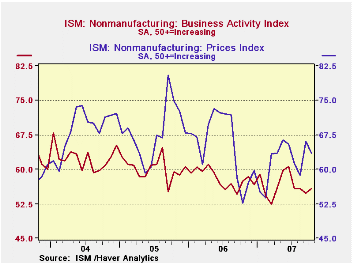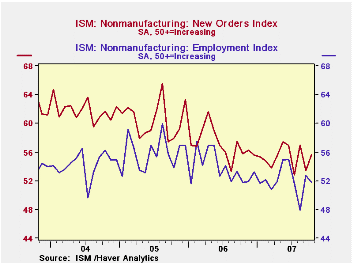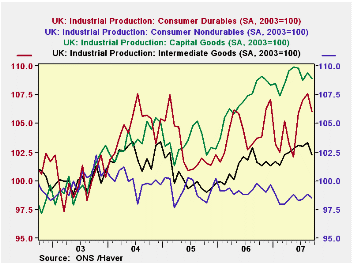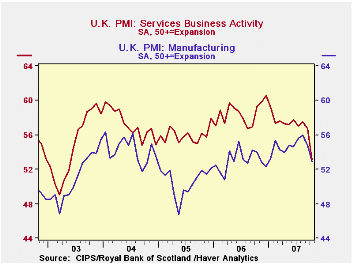 Global| Nov 05 2007
Global| Nov 05 2007U.S. ISM Non-manufacturing Index Improved Slightly
by:Tom Moeller
|in:Economy in Brief
Summary
According to the Institute for Supply Management, the October Business Activity Index for the non-manufacturing sector increased one point to 55.8. The rise made up the one point m/m decline in September and was a better reading than [...]

According to the Institute for Supply Management, the October Business Activity Index for the non-manufacturing sector increased one point to 55.8. The rise made up the one point m/m decline in September and was a better reading than Consensus expectations for a slight decline to 54.
Since the series' inception in 1997 there has been a 44% correlation between the level of the Business Activity Index in the non-manufacturing sector and the Q/Q change in real GDP for the services and the construction sectors. The correlation of the factory sector ISM index with the change in real GDP less just services is a higher 57%, though over the last ten years it only has been 34%.
The new orders sub index of the Business Activity Index
recovered most of its September decline and rose to 55.7, still down
from last year's average level of 57.1. So far this year the orders
index has averaged 55.3
The employment sub index, conversely, fell slightly to 51.8. It has averaged 52.1 this year versus 53.8 last year. Since the series' inception in 1997 there has been a 56% correlation between the level of the ISM non-manufacturing employment index and the m/m change in payroll employment in the service producing plus the construction industries.
Pricing power fell lightly m/m and for the year so far the index has averaged 61.7 versus 65.2 for all of 2006. Since inception ten years ago, there has been a 60% correlation between the price index and the q/q change in the GDP services chain price index.
ISM surveys more than 370 purchasing managers in more than 62 industries including construction, law firms, hospitals, government and retailers. The non-manufacturing survey dates back to July 1997.
The Business Activity Index for the non-manufacturing sector reflects a question separate from the subgroups mentioned above. In contrast, the ISM manufacturing sector composite index is a weighted average of five components.
Financial Instability and Monetary Policy is Federal Reserve Board GovernorFrederic S. Mishkin's speech and it is available here.
What Are the Chances? from the Federal Reserve Bank of St. Louis can be found here.
| ISM Nonmanufacturing Survey | October | September | October '06 | 2006 | 2005 | 2004 |
|---|---|---|---|---|---|---|
| Business Activity Index | 55.8 | 54.8 | 57.4 | 58.0 | 60.2 | 62.5 |
| Prices Index | 63.5 | 66.1 | 52.6 | 65.2 | 68.0 | 68.8 |
by Louise Curley November 5, 2007


Industrial production in the United Kingdom declined 0.50% in September to 99.1 (2003=100) from 99.6 in August and was 0.30% below September, 2006. Energy, which has been in a down trend for the past three years was the only major sector to increase. The production of consumer non durable and durable goods, capital goods and intermediate goods were all down, as can be seen in the first chart.
The Purchasing Managers Index of manufacturing activity for October, published last week suggests continued weakness in the manufacturing sector. The index, while still in the expansion phase (above 50), declined 3.25% from September to 52.4% in October.
Much more important, the October Purchasing Managers Index for services was released today. Services account for almost 75% of the Gross Domestic Product, while manufacturing accounts for about 15%. The service index showed a decline, almost twice as large as that of the manufacturing sector--6.37%--to 53.08%. The two PMI's are shown in the second chart.
| INDUSTRIAL PRODUCTION 2003=100 | Sep 07 | Aug 07 | Sep 06 | M/M Chg | Y/Y Chg | 2006 | 2005 | 2004 |
|---|---|---|---|---|---|---|---|---|
| Industrial Production | 99.1 | 99.6 | 99.4 | -0.50 | -0.30 | 98.8 | 98.8 | 100.8 |
| Consumer Durables | 106.0 | 107.6 | 103.7 | -1.49 | 2.22 | 104.3 | 102.9 | 104.1 |
| Consumer Nondurables | 98.5 | 98.8 | 99.8 | -0.30 | -1.30 | 99.2 | 99.2 | 100.0 |
| Capital Goods | 108.9 | 109.4 | 108.7 | -0.46 | 0.18 | 107.1 | 103.2 | 103.6 |
| Intermediate Goods | 102.2 | 103.3 | 101.6 | -1.06 | 0.59 | 101.2 | 100.1 | 102.3 |
| Energy | 85.2 | 84.6 | 85.9 | 0.71 | -0.81 | 86.2 | 91.5 | 96.4 |
Tom Moeller
AuthorMore in Author Profile »Prior to joining Haver Analytics in 2000, Mr. Moeller worked as the Economist at Chancellor Capital Management from 1985 to 1999. There, he developed comprehensive economic forecasts and interpreted economic data for equity and fixed income portfolio managers. Also at Chancellor, Mr. Moeller worked as an equity analyst and was responsible for researching and rating companies in the economically sensitive automobile and housing industries for investment in Chancellor’s equity portfolio. Prior to joining Chancellor, Mr. Moeller was an Economist at Citibank from 1979 to 1984. He also analyzed pricing behavior in the metals industry for the Council on Wage and Price Stability in Washington, D.C. In 1999, Mr. Moeller received the award for most accurate forecast from the Forecasters' Club of New York. From 1990 to 1992 he was President of the New York Association for Business Economists. Mr. Moeller earned an M.B.A. in Finance from Fordham University, where he graduated in 1987. He holds a Bachelor of Arts in Economics from George Washington University.






